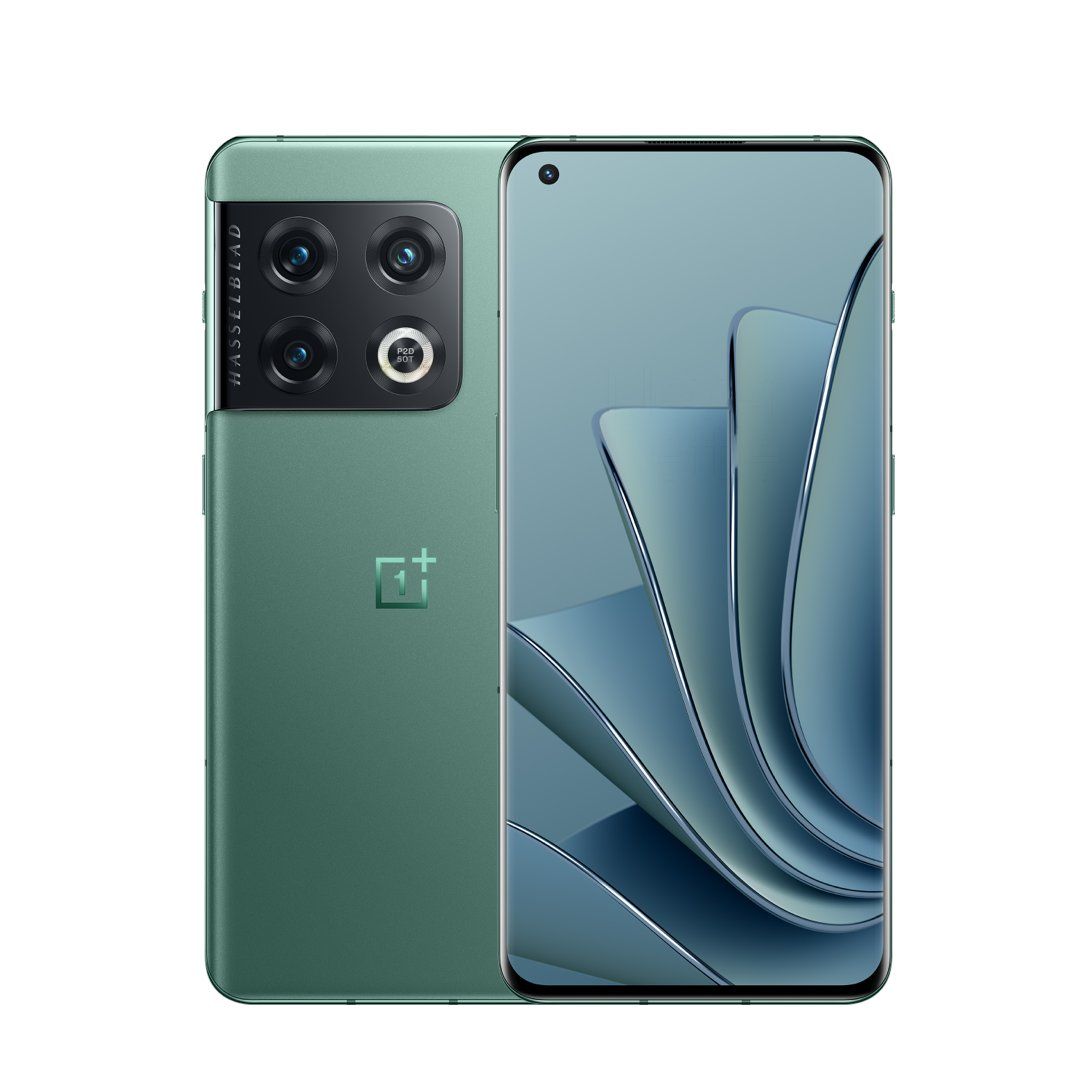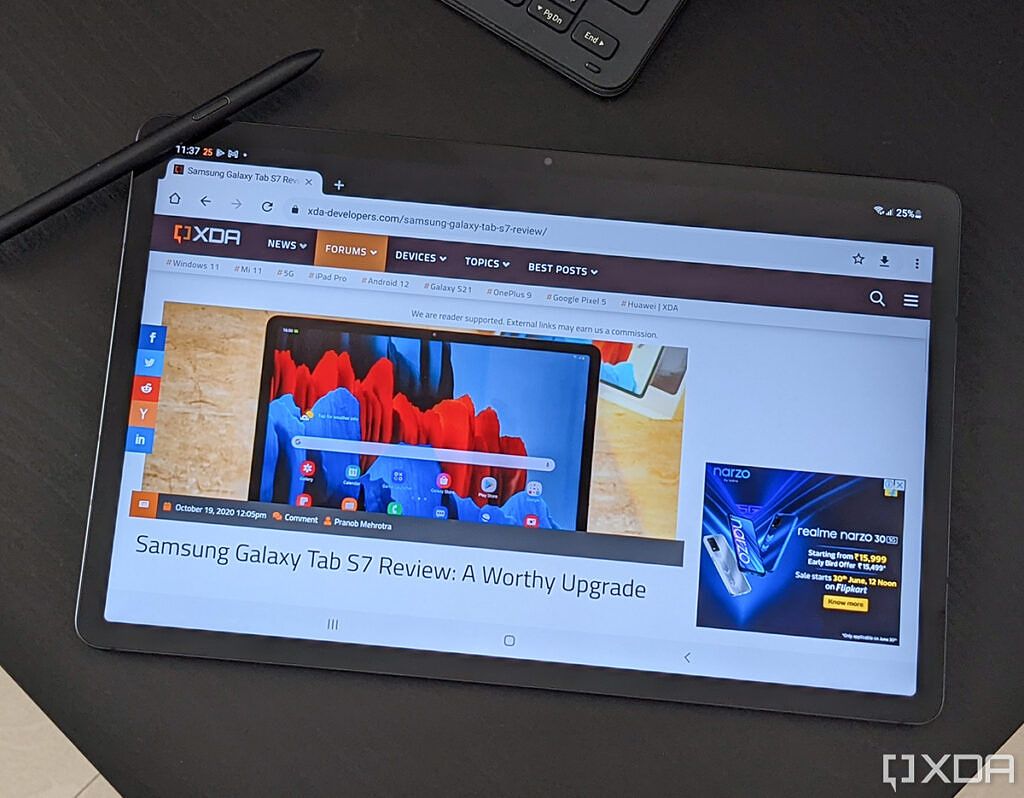The OnePlus 10 Pro positions itself as a premium Android flagship on the market. It offers a good set of internals for the price, but it’s only a marginal upgrade — if at all — over the OnePlus 9 Pro from last year. So despite having a “Pro” moniker, the OnePlus 10 Pro often finds itself competiting with more standard phones on the market. In this article, we’re going to take a look a look at the OnePlus 10 Pro vs Apple iPhone 13 to find out how the latest and greatest flagship from OnePlus compare to one of the finest iPhones out there.
Navigate this article:
OnePlus 10 Pro vs Apple iPhone 13: Specifications
Before we begin the comparison, let’s take a quick look at the specifications of each phone to find out what they bring to the table:
| Specification |
OnePlus 10 Pro |
Apple iPhone 13 |
| Build |
- Aluminum mid-frame
- Gorilla Glass 5 back
- Gorilla Glass Victus front
- IP68 rating (only on T-Mobile models)
|
- Aluminum mid-frame
- Glass front and back
- “Ceramic Shield” for front glass
- IP68 rating
|
| Dimensions & Weight |
- 163 x 73.9 x 8.55 mm
- 201g
|
- 146.7mm x 71.5mm x 7.65mm
- 174g
|
| Display |
- 6.7-inch QHD+ 120Hz Fluid AMOLED
- 1,440 x 3,216 pixels
- Variable refresh rate between 1Hz to 120Hz
- 1300 nits peak brightness
- HDR10+ certified
|
- 6.1-inch Super Retina XDR OLED
- 2,340 x 1,080 resolution
- 60Hz refresh rate
- 1300 nits peak brightness
- HDR10
- True tone display
|
| SoC |
- Qualcomm Snapdragon 8 Gen 1 SoC
|
|
| RAM & Storage |
- 8GB/12GB RAM
- 128GB/256GB/512GB UFS 3.1 storage
|
- 4GB RAM
- 128GB/256GB/512GB
|
| Battery & Charging |
- 5,000mAh
- 65W wired fast charging (North America)
- 80W wired fast charging (Everywhere outside of North America)
- 50W wireless charging
- Reverse wireless charging
- Charger included in box
|
- 3,240 mAh
- Wired charging up to 20W
- Wireless charging up to 7.5W
- MagSafe charging up to 15W
- Charger not included in the box
|
| Security |
Optical in-display fingerprint scanner |
Face ID |
| Rear Camera(s) |
- Primary: 48MP wide, f/1.8, 1/1.33″, OIS
- Secondary: 50MP ultra-wide, f/2.2/150˚ FOV
- Tertiary: 8MP telephoto, 3.3x optical zoom
- Hasselblad color calibration
|
- Primary: 12MP wide, f/1.6 aperture, 1.6μm
- Secondary: 12MP ultra-wide, f/2.4 aperture
|
| Front Camera(s) |
32MP, f/2.2/0.8µm |
12MP TrueDepth camera system |
| Port(s) |
- USB Type-C
- No headphone jack
- No microSD card slot
|
- Lightning port
- No headphone jack
- No microSD card slot
|
| Audio |
|
|
| Connectivity |
- 5G (mmWave) for almost all regions and carriers except AT&T in the US
- Wi-Fi 6 (802.11ax) with 2×2 MIMO
- Bluetooth 5.2
- NFC
- GPS, Galileo, GLONASS, BeiDou
|
- 5G (sub-6 GHz and mmWave)
- Gigabit LTE with 4×4 MIMO and LAA
- Wi-Fi 6 (802.11ax) with 2×2 MIMO
- Bluetooth 5.0
|
| Software |
- China: ColorOS 12.1 based on Android 12
- Global: OxygenOS 12.1 based on Android 12
|
iOS 15 |
| Other Features |
- Dual physical SIM
- Alert slider
- Three major Android OS updates promised
- Four years of security patches
|
- Apple Pay
- eSIM support
- Compatible with MagSafe accessories
|
Design and Display

The OnePlus 10 Pro carries a very familiar design aesthetics with its rounded edges and subtle curves at the front and the back where the glass panels meet the mid-frame. The main differentiator this year is the camera island, which is quite polarizing, to say the least. Some people seem to like this design, while others think it’s not as elegant as some other phones we’ve seen from the brand in the past. Meanwhile, the iPhone 13 looks like any other glass slab smartphone with hard corners and flat sides. It also has a familiar-looking camera island at the back to house the dual-camera setup.
Regardless of what you think about the looks, there’s no denying that the OnePlus 10 Pro feels more comfortable to hold in hand while using it. And that’s despite the fact that the OnePlus 10 Pro is significantly taller, thicker, and the heavier phone in this comparison. Phones with curved sides tend to sit nicely in hand, and that’s exactly the case with the OnePlus 10 Pro. The matte texture at the back of the device also adds to the overall premium finish of the phone.

iPhone 13
Both phones have an aluminum mid-frame and glass on both the front as well as the back. The OnePlus 10 Pro uses Gorilla Glass Victus to protect the display, while the iPhone 13 has “Ceramic Shield” for front glass. All the iPhones this year carry an IP68 rating for dust and water resistance, but only the T-Mobile variants of the OnePlus 10 Pro come with an “official” IP rating. You get a USB-C port at the bottom of the OnePlus 10 Pro while the iPhone 13 comes with a lighting port for charging and data syncing. OnePlus’ signature alert slider — which now seems to be getting removed from a lot of OnePlus devices — makes an appearance on the OnePlus 10 Pro. The iPhone 13 also comes with a ring/silent switch on the left-hand side.

OnePlus 10 Pro in sandstone black case
Moving on to the display, the OnePlus 10 Pro features a significantly bigger 6.7-inch display with minimal bezels and a punch-hole camera cutout on the top for the selfie camera. The iPhone 13 looks exactly like many other iPhones from the last couple of years with a notch on the front and relatively thick, yet uniform bezels on the rest of the three sides. The OnePlus 10 Pro definitely looks more modern from the front, but we’ll leave it up to you to decide which one’s better. It’s a matter of taste, after all.
Aesthetic differences aside, the OnePlus 10 Pro definitely has a better display on paper. It’s a 6.7-inch AMOLED panel with support for a max resolution of 3216 x 1440 pixels, meaning it has around 525 ppi. The iPhone 13’s smaller 6.1-inch Super Retina XDR OLED display isn’t as sharp as the OnePlus 10 Pro’s panel because it only supports a maximum resolution of 2532 x 1170 pixels, which works out to about 460 ppi. Not to mention, the OnePlus 10 Pro also supports a 120Hz refresh rate which paves the way for smooth scrolling and other animations on the screen.

Both smartphones are built to last but the OnePlus 10 Pro looks more modern. The iPhone 13 doesn’t look bad, but the iPhones, in general, desperately need a design refresh to go against the modern Android flagships. The differences are more prominent when you move over to the display as the OnePlus 10 Pro’s AMOLED panel is not only bigger, but it’s also better equipped to offer a more refined experience.
Hardware and Software
The OnePlus 10 Pro has the latest Snapdragon 8 Gen 1 chipset, up to 12GB RAM, and up to 256GB of internal storage. It’s one of the most powerful Android phones you can buy on the market right now. In comparison, the iPhone 13 packs Apple’s A15 Bionic chip with 4GB of RAM and up to 512GB of internal storage. The A15 Bionic is an insanely powerful chipset, which easily beats the Snapdragon 8 Gen 1 when it comes to general performance. In real-world usage, however, you’re going to get the same experience from both devices. You may not see a noticeable difference unless you’re really pushing both phones to their limits, so there’s nothing to worry about. Apple’s iOS, as you probably already know, handles everything without a hitch even with less memory at its disposal, and it’s the same in the case of the iPhone 13 too.

The base variant of both phones ships with 128GB of internal storage and you can choose to splurge more to get a maximum of 512GB of storage with each phone. You can’t add a microSD card to add more storage to either of these devices, so be sure to pick the right storage variant. Moving over the battery department, the OnePlus 10 Pro packs a massive 5,000 mAh battery inside, whereas the iPhone 13 trails behind with a significantly smaller 3,240 mAh battery unit. This makes it seem like the OnePlus 10 Pro is better in the battery department, but that’s not really the case. Apple’s A15 Bionic chip and iOS software work their magic to make iPhone 13’s battery last really long between charges. Both phones should be able to last for at least a day and a half with moderate usage.
The OnePlus 10 Pro pulls ahead of the iPhone 13 with its fast-charging capabilities, though. The OnePlus 10 Pro models in the US support 65W charging while the units sold in the rest of the world support up to 80W charging. The iPhone 13 only supports fast charging up to 20W. One of the best things about the OnePlus 10 Pro is that it comes with that fast charger in the box, while the iPhone 13 doesn’t. You also get wireless charging support with both phones, but that’s also significantly faster on the OnePlus 10 Pro.

Overall, both phones are comparably fast when it comes to performance, but the OnePlus 10 Pro takes the crown in the battery department with its fast-charging capabilities. iPhones continue to remain painfully slow when it comes to charging, and we hope things change with the upcoming iPhone 14.
On the software side, the OnePlus 10 Pro ships with OxygenOS 12 that’s based on Android 12. The iPhone 13 comes with iOS 15 and will receive the stable build of iOS 16 when it arrives later this year. The difference is entirely subjective when it comes to software as both Android and iOS have advantages and disadvantages of their own. OnePlus, however, seems to be having a tough time with its OxygenOS. The past couple of versions of the software have been quite unstable. Not to mention, the OnePlus phones haven’t been receiving timely updates either. Apple’s iOS, thankfully, isn’t plagued by any of these issues as the company continues to deliver a largely polished software experience to its users. Bugs on iOS are usually limited to beta releases, and what you end up with on the phone is software that just works, albeit somewhat limited in its experience.
Cameras
The OnePlus 10 Pro sports a triple camera setup at the back which includes an f/1.8, 1/1.43-inch Sony IMX789 main camera; an 8MP, f/2.4 telephoto zoom lens with 3.3x optical zoom; and a 50MP, f/2.2 ultra-wide camera. By contrast, the iPhone 13 only has two rear cameras — a 12MP, f/1.6 wide and a 12MP, f/2.6 ultrawide lens. The OnePlus 10 Pro is definitely more versatile, but the iPhone 13 is more reliable with its photos and videos. It consistently captures well-balanced images with more details and better colors compared to the OnePlus 10 Pro’s shots. That’s not to say the images captured using the OnePlus 10 Pro look bad. They’re just not as consistent as the ones captured using an iPhone 13. We’ll leave some camera samples below to give you a better understanding of what to expect from each of these devices.

The OnePlus 10 Pro features a 32MP selfie shooter on the front, whereas the iPhone 13 uses a 12MP camera for selfies and video calls. As far as the videos are concerned, the OnePlus 10 Pro can record 8K videos at 24fps or 4K videos at up to 60fps. Apple’s iPhone 13 tops out 4K resolution with up to 60fps, but it captures better-looking footage. iPhones continue to remain the king of videos on mobile, and that’s true in the case of this comparison too.
OnePlus 10 Pro camera samples:

iPhone 13 camera samples:





OnePlus 10 Pro vs Apple iPhone 13: Which one should you buy?
The OnePlus 10 Pro starts at $899 in the US while the iPhone 13 will cost you $799 for the base variant with 128GB storage. The OnePlus 10 Pro vs iPhone 13 is a tough match-up because you also have to consider the “Android vs iOS” debate in addition to other factors; and more often than not, which OS you prefer will end up dictating your hardware choice. The OnePlus 10 Pro is a great all-rounder, but we think it doesn’t do enough to rope in those who are fully immersed in the Apple ecosystem. You definitely have better options on the market if you’re looking to switch from iOS to Android. That’s not to say it’s a bad phone because the OnePlus 10 Pro is one of the fastest Android flagships on the market right now. It also comes with an impressive 6.7-inch AMOLED display and an open Android experience to please the die-hard Android users. OnePlus’ software game, however, isn’t as strong as it once used to be, and it also fails to impress with its inconsistent cameras.
The iPhone 13 shines in all these departments, as it offers a reliable software experience and is also slated to receive more updates in the future compared to the OnePlus 10 Pro. The iPhone 13 may not have a versatile camera setup, but its dual-camera system consistently churns out better images both day and night. You can also pick up the iPhone 13 Pro if you want better camera systems to go against other modern flagships on the market. The only disadvantage of buying an iPhone 13 over the OnePlus 10 Pro is that you’ll have to put up with slower charging speeds and a smaller 60Hz display.
All things considered, both the OnePlus 10 Pro and the iPhone 13 offer a good experience overall. You’re not necessarily buying a bad phone by picking either of these devices, but the iPhone 13 happens to deliver a more polished experience compared to the OnePlus phone. You can also read our reviews of each of these phones (linked earlier in the article) to learn more about them in detail. Alternatively, you can also check out our OnePlus 10 Pro vs iPhone 13 Pro comparison if you’re interested to see how the more expensive iPhone stacks up against the OnePlus flagship.
The OnePlus 10 Pro is the latest and greatest flagship smartphone from OnePlus, and packs some of the best performing hardware into one package.
The iPhone 13 brings the powerful A15 Bionic and a really good main camera along with the usual Apple package of great software and eco-system.
Be sure to take a look at our OnePlus 10 Pro deals and the iPhone 13 deals page to see if you can find some good deals on these phones while you’re here. We’ve also rounded up some of the best OnePlus 10 Pro cases and the best iPhone 13 cases if that’s something you’re interested in buying.
The post OnePlus 10 Pro vs Apple iPhone 13: Which phone is better to buy in 2022? appeared first on XDA.
from XDA https://ift.tt/oDNnmAU
via
IFTTT







 Rethinking your message? Now you’ll have a little over 2 days to delete your messages from your chats after you hit send.
Rethinking your message? Now you’ll have a little over 2 days to delete your messages from your chats after you hit send.







































